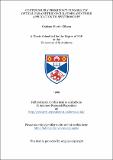Files in this item
Continuously frequency-tunable CW optical parametric oscillators and their application to spectroscopy
Item metadata
| dc.contributor.advisor | Dunn, Malcolm H. | |
| dc.contributor.advisor | Padgett, Miles | |
| dc.contributor.author | Gibson, Graham Martin | |
| dc.coverage.spatial | 185 p. | en_US |
| dc.date.accessioned | 2018-07-05T08:16:39Z | |
| dc.date.available | 2018-07-05T08:16:39Z | |
| dc.date.issued | 1999-05 | |
| dc.identifier.uri | https://hdl.handle.net/10023/14950 | |
| dc.description.abstract | This thesis describes the development and applications of single-frequency, continuously tunable, continuous-wave (cw), optical parametric oscillators (OPOs). Two doubly-resonant OPOs (DROs) are presented, one providing tunable light around 1?m, the other specifically designed as a spectroscopic source for methane near 1649nm. Once stabilised, the frequency-selective nature of the DRO ensures operation on a single mode-pair without the need for additional intracavity frequency-selective components. Both DROs are smoothly tunable by smoothly tuning the pump laser. The 1mum DRO is based on a bulk KTP crystal cut for near-degenerate, type-II, critical phase-matching (theta= 90°, ϕ = 37°). Angle tuning the crystal provides coarse tuning of the output frequencies over a range of ~50nm. Small perturbations to the OPO cavity is sufficient to cause a systematic mode-hop and provides a method of tuning across the phase-matching bandwidth (~0.5THz). This DRO is demonstrated as a spectroscopic source by recording the absorption spectrum of cesium molecules near 1050nm. The DRO as a potentially compact source of tunable light is demonstrated by using a frequency-doubled microchip laser as the pump source. The output consists of a single pair of signal and idler modes even when using a multilongitudinal-mode pump laser. Smooth tuning of the output frequencies is achieved by temperature tuning the pump laser. The 1.65mum DRO is based on periodically poled KTiOPO4 (PPKTP). The suitability of PPKTP for cw OPOs was first assessed by a difference frequency generation experiment from which the effective d33 coefficient was estimated to be ~5mum/V. The idler wavelength is coarsely tuned at a rate of 0.73nm/°C by varying the crystal temperature. A combination of computer modelling and experimental observation is used to study the dynamic behaviour of a DRO. The numerical model calculates the time required for the OPO to build-up from the parametric fluorescence and is in excellent agreement with experimental observations. | en_US |
| dc.language.iso | en | en_US |
| dc.publisher | University of St Andrews | |
| dc.subject.lcc | TK7872.O7G5 | |
| dc.subject.lcsh | Ocillators | |
| dc.subject.lcsh | Optical parametric oscillators | |
| dc.title | Continuously frequency-tunable CW optical parametric oscillators and their application to spectroscopy | en_US |
| dc.type | Thesis | en_US |
| dc.type.qualificationlevel | Doctoral | en_US |
| dc.type.qualificationname | PhD Doctor of Philosophy | en_US |
| dc.publisher.institution | The University of St Andrews | en_US |
This item appears in the following Collection(s)
Items in the St Andrews Research Repository are protected by copyright, with all rights reserved, unless otherwise indicated.

